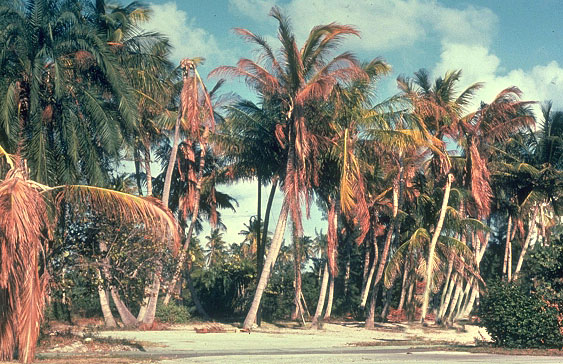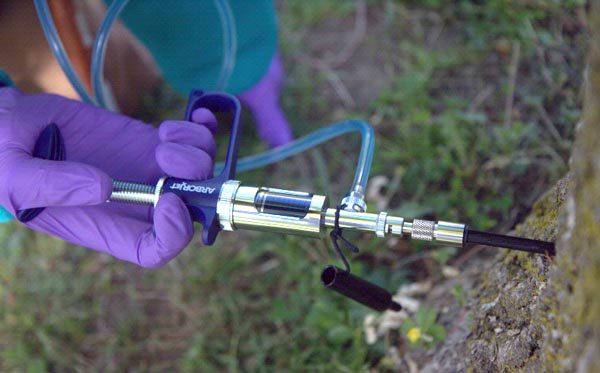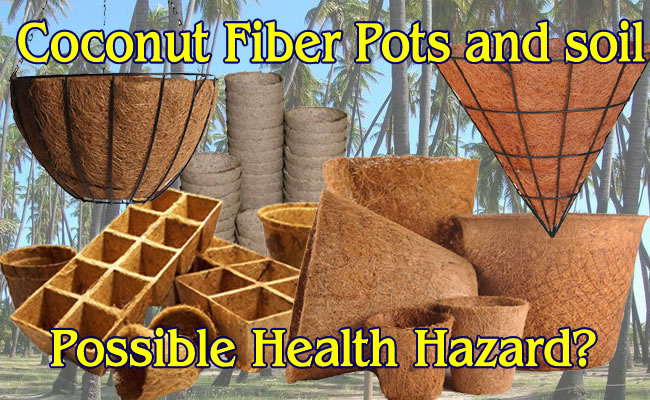Quite a few potting soils today use Coconut Coir Fiber instead of sphagnum peat moss as the base for their mixes. It’s that fibery stuff that comes between the outer shell of the coconut and the inner bit that you eat. This material is trumpeted as better since it is a renewable resource from coconut trees and it is easily sterilizable. Once hydrated it can hold almost nine times its weight in water and then allow the rest of the water to drain away without getting waterlogged. It can be milled fine to be used in seed starting mixes or left with slightly longer fibers for use in potting mixes for larger plants.
Most gardeners are probably more familiar with Coconut Coir Fiber being used as hanging basket planters and small biodegradable pots. These have been gaining in popularity recently for two reasons: first they don’t break down quite as fast as peat pots making them easier for many people to handle, and again they are trumpeted as a renewable resource.
But sadly they are not renewable. Not any more.
Maybe you have heard of it, maybe not. It’s called Coconut Lethal Yellowing Disease (LYD)and it’s killing the world’s coconut population. It has already decimated the trees in many countries. The hardest hit so far are those in North America, especially Mexico and the Caribbean. It has also hit Africa, parts of India and the Pacific Islands. Many of these small countries rely on the coconut industry, it is one of the staples of their economy. In some places over 90% of the native palms have been exterminated by this disease. [1,2]

The problem is there is no cure. There are just two choices.
1. Cut down and burn any infected trees to stop the spread of the disease.
2. Treat the trees with antibiotics. Mostly oxytetracycline (OTC) is used. The antibiotic is injected into the trunk of the tree. This has to be done every 4 months for the life of the tree. It won’t cure it but it will keep the disease at bay so that the tree will live. [3,4,5]
This second method is being used extensively in resort areas. Most areas that rely on tourists want to keep their palm trees. After all that’s what the tropics are about. How can you have an exotic tropical resort without the palm trees? No one wants to be around a bunch of ugly dead tree stumps.
Areas like Florida also use OTC on their ornamental trees. Over the last 40 years Florida has lost a huge number of palms especially coconuts to LYD so using antibiotics to keep the ambiance in places like the Florida keys is essential. They also put out leaflets warning everyone NOT to eat the fruits (coconuts) of the treated trees [6]. A fairly high level of antibiotics is needed to keep the trees ‘healthy’ a lot of that is going to get concentrated into the fruit. You really don’t want to eat that.

WHO IS USING ANTIBIOTICS?
The crisis of the coconut is massive, but the demand for coconut products is still rising. With the advent of coconut water in the last few years heralded as the ‘latest super food’ demand is increasing not decreasing. While research into the problem continues trees are being fed antibiotics. In countries where the coconut is the main agricultural staple providing most of their export products financial ruin may occur if all the trees die and their crops are decimated. Whether these plantations use antibiotics to stave the disease off their trees is unknown, it’s unlikely they are going to advertise the fact to anyone. Perhaps the fruits are not being incorporated into our food chain but what about the fiber? This is not a food so it would not come under the same rules. There is nothing to stop anyone grinding up the fiber from treated trees and selling it as potting soil or using it for plant starter pots.
Is this safe?
Digging into the research on antibiotics and OTC specifically gets a little concerning. The stuff is used quite a bit in veterinary medicine so there is research about it’s stability which is fairly high. There is even research about it’s stability which is fairly high. There is not a lot of research about how stable it is in soil and how long it will last but piecing together lots of different studies it appears that:
1. It’s fairly stable in soil and can last around 10-15 days on it’s own in cool soil..[7]
2. It’s not affected by heat, it’s even more stable. Can take being boiled for 30 minutes before it starts to break down at any point. [8]
3. Much more stable in the dark.
4. Breaks down in more alkaline conditions but in ph neutral or slightly acidic conditions it can last over 60 days or more. [9]
5. Breaks down in sunlight much faster. [10]
What does this mean for your starter pots.
Since OTC breaks down in sunlight its probably fine for hanging basket liners where they are exposed to the sun a lot. If using coconut fiber starter pots make sure that the pots have a lot of sun exposure from the moment that they are used. Do not crowd them together or put them in an area where they don’t get a lot of light.
What about the potting mix?
Its hard to determine exactly how long the antibiotics are going to stay around in the soil. It could be a few days or it could be up to 60 days. The research that does exist on antibiotics and OTC in the soil all states that there is a reduction in soil biology and activity. Basically it kills off all the good stuff in the soil that you really need to make your plant healthy. The only way that they were able to improve the soil biology again was to add manure which basically reintroduced a lot of the microflora that they had just killed off.
If these substances are as stable as some research suggests then these substances are going to be transferred to your garden when you transplant the seedling. This means it could spread the problem to a larger area of your soil. The intention is to build and create a good soil microflora to keep your plants healthy and strong. Killing all this off with antibiotics achieves the complete opposite of what we want. [11 – 14]
Is OTC taken up by the plants?
There is little to no research being conducted on the uptake of antibiotics by plants. What little there is has reported that there was a change in the carbon source utilization and content. [15] Others reported that soil respiration was vastly decreased, meaning basically everything in the soil is dead. Others reported that there was a decrease in the growth of the tested plants, most likely due to the death of any soil microbes. [16]
There is no doubt that if the antibiotics survive in the soil that the plants will come into contact with them. How they are treated by the plant and if they are taken up is unknown. [17, 18]
So Is it safe for me and my family?
The simple answer is no one knows. For safety refrain from growing anything that you intend to eat in soil that may have antibiotics included. Flowers and other plants that are not intended for consumption are most likely fine but bear in mind that you may be destroying your soil biology when planting this material in your garden.
References
[1] The end of coconut water? The world’s trendiest nut is under threat of species collapse
[2] The World’s Coconuts Are in Danger
[3] Lethal yellowing disease of the coconut palms (cocos nuciferal.): An overview of the crises
Eziashi, E.* and Omamor, I.
African Journal of Biotechnology Vol. 9(54), pp. 9122-9127, 29 December, 2010
[4] Coconut Lethal Yellowing Diseases: A Phytoplasma Threat to Palms of Global Economic and Social Significance
Geoff M. Gurr,1 Anne C. Johnson, Gavin J. Ash, Bree A. L. Wilson, Mark M. Ero, Carmel A. Pilotti, Charles F. Dewhurst, and Minsheng S. You
Front Plant Sci. 2016; 7: 1521.
[5] Lethal yellowing of palm
Harrison, N.A. and M.L. Elliott. 2008. Lethal Yellowing of Palms. The Plant Health Instructor. DOI: 10.1094/PHI-I-2008-0714-01
[6] Dont Eat Coconuts From Trees Treated For Lethal Yellowing
[7] Pharmacokinetics and pharmacodynamics of the tetracyclines including glycylcyclines
Kenneth N. Agwuh1 and Alasdair MacGowan2 *
Journal of Antimicrobial Chemotherapy (2006) 58, 256–265 doi:10.1093/jac/dkl224
[8] Thermal stability assessment of antibiotics in moderate temperature and subcritical water using a pressurized dynamic flow-through system
Ola Svahn and Erland Björklund
International Journal of Innovation and Applied Studies ISSN 2028-9324 Vol. 11 No. 4 Jun. 2015, pp. 872-880 © 2015 Innovative Space of Scientific Research Journals
[9] Degradation of Oxytetracycline, Streptomycin, Sulphathiazole and Chloramphenicol Residues in Different Types of Honey
Milica Gačić1, Nina Bilandžić2, Đurđica Ivanec Šipušić1, Marinko Petrović1, Blaženka Kos3*, Nada Vahčić3
and Jagoda Šušković3
[10] Stability of penicillin G, ampicillin, amikacin and oxytetracycline and their interactions with food in in vitro simulated equine gastrointestinal contents
McKellar, Quintin; Horspool, L. J.
[11] Toxicity of the antimicrobial oxytetracycline to soil organisms in a multi-species-soil system (MS.3) and influence of manure co-addition.
Boleas S1, Alonso C, Pro J, Fernández C, Carbonell G, Tarazona JV.
J Hazard Mater. 2005 Jul 15;122(3):233-41. Epub 2005 Apr 7.
Journal of Hazardous Materials Volume 122, Issue 3, 15 July 2005, Pages 233–241
[12] Oxytetracycline on functions and structure of soil microbial community
W. Chen1*, W. Liu1 , N. Pan2 , W. Jiao1 , and M. Wang1
Journal of Soil Science and Plant Nutrition , 2013,13 (4), 967-975
[13] Effects of six selected antibiotics on plant growth and soil microbial and enzymatic activities
Feng Liu a , Guang-Guo Ying a,*, Ran Tao a , Jian-Liang Zhao a , Ji-Feng Yang a , Lan-Feng Zhao b
Environmental Pollution 157 (2009) 1636–1642
[14] Toxicity of the antimicrobial oxytetracycline to soil organisms in a multi-species-soil system (MS.3) and influence of manure co-addition.
Boleas S1, Alonso C, Pro J, Fernández C, Carbonell G, Tarazona JV.
J Hazard Mater. 2005 Jul 15;122(3):233-41. Epub 2005 Apr 7.
[15 ] Effect of veterinary oxytetracycline on functional diversity of soil microbial community
W. Liu1, N. Pan2, W. Chen1, W. Jiao1, M. Wang1
PLANT SOIL ENVIRON., 58, 2012 (7): 295–301
[16] Association Efficiency of Three Ionic Forms of Oxytetracycline to Cationic and Anionic Oil-In-Water Nanoemulsions Analyzed by Diafiltration
Authors Sandra L. Orellana,Cesar Torres-Gallegos,Rodrigo Araya-Hermosilla,Felipe Oyarzun-Ampuero,Ignacio Moreno-Villoslada
Journal of Pharmaceutical Sciences Volume 104, Issue 3, pages 1141–1152, March 2015
[17] Tetracycline Antibiotics
Copyright, Purdue Research Foundation, 1996
[18] Uses of Antimicrobials in Plant Agriculture
Anne K. Vidaver
Clin Infect Dis (2002) 34 (Supplement_3): S107-S110.

